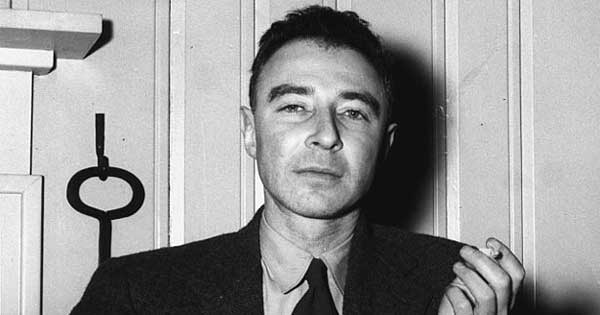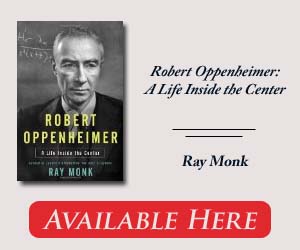
Robert Oppenheimer: A Life Inside the Center, By Ray Monk, Doubleday, 825 pp., $37.50
Sixty-eight years into the atomic age, North Korea routinely threatens a preemptive nuclear attack on the United States, while a nuclear-armed Israel warily eyes Iran’s efforts to build its own weapons of mass destruction. That we live on the edge of apocalypse is surely one of the reasons that American physicist Robert Oppenheimer, father of the first atomic bomb and symbol of its moral ambiguities, remains such a tantalizing subject for biographers. The latest to weigh in is Ray Monk, a philosophy professor at England’s University of Southampton, whose Robert Oppenheimer: A Life Inside the Center charts his subject’s path from outsider to quintessential insider—the polymath at the heart of some of the most crucial events of the first half of a brutal century.
Monk gives us the basics: Oppenheimer was born in 1904 into a wealthy, secular Jewish family in New York. Discovering physics in high school, he described the field to his younger brother as having “a beauty which no other science can match, a rigor and austerity and depth.” He raced through Harvard, Cambridge, and Germany’s University of Göttingen before returning to the United States to build its leading center of theoretical physics at the University of California at Berkeley. Like many intellectuals in the 1930s, he closely associated himself with leftwing politics and had numerous Communist friends, including the woman who became his wife, though he himself never joined the party. During World War II, Oppenheimer led the secret effort to build an atomic bomb at Los Alamos, New Mexico, but after Hiroshima and Nagasaki he declared that physicists “had known sin” and determined to lead the way to international control of nuclear weapons. He went on to be labeled a security risk during the McCarthy era and was effectively expelled from government service. Oppenheimer would spend the final 18 years of his life as director of the prestigious Institute for Advanced Study in Princeton, New Jersey.
But as Monk writes, personal and political details like those ignore the science that informed Oppenheimer’s life. As a case in point, he cites Martin Sherwin and Kai Bird’s 2005 Pulitzer Prize–winning American Prometheus: The Triumph and Tragedy of J. Robert Oppenheimer, which he calls “a very fine book indeed, a monumental piece of scholarship.” That it was published to rave reviews eight years into Monk’s 15-year labor gave him pause. Happily, he soldiered on, for his Robert Oppenheimer is a fine book and a monumental piece of scholarship in its own right. Monk adds another dimension to the story by interpreting the physics that was, after all, Oppenheimer’s central preoccupation.
Monk’s grasp of the science heightens the drama, as it places his subject squarely in the middle of the quantum mechanics revolution. He writes, for example, about the first two papers Oppenheimer published as a student at Cambridge, even while battling depression. They won him a spot at Göttingen, where he regained his emotional balance and became part of a band of “boy” physicists who rocked the world of nuclear physics. Many of them would join him on the mesa in New Mexico and later in Princeton, where Oppenheimer mixed the now-older “wunderkinds” with a new generation of boy wonders and in the process facilitated breakthroughs that would earn some of them Nobel prizes.
In the writing, Monk occasionally ladles on too many details or wanders into lengthy digressions. A long first chapter tells the history of German Jews in New York near the turn of the 20th century, assuming that Oppenheimer’s Jewishness was a major influence in his life. Monk is better when he focuses on the philosophy behind the Ethical Culture Society, whose school the young Oppenheimer attended. Founded by Felix Adler, who broke away from a Reform Jewish synagogue, the society was based on moral principles and was “open to both worshipper and infidel.” Monk traces its roots to Adler’s version of Immanuel Kant’s moral law: “Act so as to bring out the spiritual personality, the unique nature of the other.” Monk clearly connects how these early influences affected Oppenheimer’s worldview.
Elsewhere Monk simply offers a more elaborate account of some well-known episodes—such as when the American bomb project was floundering, and British physicists intervened to convince the Roosevelt administration that the bomb could be produced in time to win the war. But he often unearths new details that add clarity to these old stories and moves the reader by degrees to a better understanding of his subject.
Monk is less interested in Oppenheimer’s private life, which may explain his haphazard approach to personal details. He does not dwell on the alcoholism that plagued his wife, Kitty Oppenheimer, and wreaked havoc with the family. He also repeats without challenge the tropes about her self-proclaimed background as a German princess with connections to the royal houses of Europe, except to say that if her father was a “princeling,” it is a mystery why he would be an engineer seeking work in America. Occasionally he makes an outright mistake: he writes that Kitty spent her last five years with close friends Robert and Charlotte Serber, but Charlotte committed suicide only weeks after Oppenheimer’s death in 1967. Kitty did live with Serber, who after Kitty’s death would cheerfully repeat the stories she told him about her royal roots.
 Monk writes well, and the errors do not amount to much in the great expanse of the story. But I hope Oppenheimer’s next biographer might consider starting from the end and moving toward the beginning. Oppenheimer worked almost until his death, yet Sherwin and Bird gave only 22 pages to everything after the 1953 government hearing that robbed him of his security clearance; Monk does better with 46. Oppenheimer was not silent during those last years; he traveled the country and the world, giving speeches to which both scientists and nonscientists, myself included, flocked. Even when the subject of a lecture was purely scientific, Oppenheimer emphasized his central message of how, in the atomic age, it could be possible to preserve a life worth living. At a 1963 Chicago symposium called Challenges to Democracy, he put it this way: “What we do have is an increasingly wide and deep understanding of the terror and horror and wrongness of war, of the irreversibility of the powers acquired by our knowledge of nature.” He spoke of mankind’s responsibilities, said that the need to love the past and cherish the future was not enough, that what we must come to understand was that “evil is the monopoly of no people, that we can and must see it in ourselves and even in our own country.”
Monk writes well, and the errors do not amount to much in the great expanse of the story. But I hope Oppenheimer’s next biographer might consider starting from the end and moving toward the beginning. Oppenheimer worked almost until his death, yet Sherwin and Bird gave only 22 pages to everything after the 1953 government hearing that robbed him of his security clearance; Monk does better with 46. Oppenheimer was not silent during those last years; he traveled the country and the world, giving speeches to which both scientists and nonscientists, myself included, flocked. Even when the subject of a lecture was purely scientific, Oppenheimer emphasized his central message of how, in the atomic age, it could be possible to preserve a life worth living. At a 1963 Chicago symposium called Challenges to Democracy, he put it this way: “What we do have is an increasingly wide and deep understanding of the terror and horror and wrongness of war, of the irreversibility of the powers acquired by our knowledge of nature.” He spoke of mankind’s responsibilities, said that the need to love the past and cherish the future was not enough, that what we must come to understand was that “evil is the monopoly of no people, that we can and must see it in ourselves and even in our own country.”
North Korea and Iran, he would seem to say, notwithstanding.
By tracing the far reaches of Oppenheimer’s mind, Monk comes closest to finding the center he sought—and takes readers with him.

